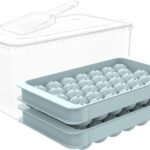Mini Fridger production involves a complex process that combines design, manufacturing, and quality control to create compact refrigerators. This article provides a glimpse into the behind-the-scenes operations of mini Fridger production.

Each step is crucial in ensuring a high-quality and efficient mini fridge from the initial design stage to the final product testing. Throughout production, manufacturers utilize advanced technology, modern machinery, and skilled labor to meet the growing demand for these compact appliances.
By understanding the various aspects of mini Fridger production, consumers can gain insight into the intricate process behind these innovative household appliances.
Unveiling Mini Fridge Manufacturing
The Assembly Line Journey
Mini fridge production involves a meticulous assembly line process that ensures efficiency and precision. Multiple components and materials are used to create these appliances, with each part playing a crucial role in their functionality.
The journey starts with the collection of key components and materials. These may include compressors, condensers, evaporators, refrigerants, and insulation materials. Each element is sourced carefully to ensure high quality and durability.
In terms of assembly, there are debates about automation versus manual methods. Automation brings speed and consistency to the production process, reducing the risk of errors. On the other hand, manual assembly allows for greater flexibility and customization options.
Ultimately, finding the right balance between automation and manual labor is crucial. Manufacturers strive to optimize their assembly lines by utilizing automated systems for repetitive tasks while also relying on skilled workers for intricate procedures.
Design Evolution And Innovations
The production of mini fridges has come a long way in terms of design evolution and innovations. One of the notable shifts in design is from bulky to sleek, making these appliances more visually appealing and space-saving. The modern mini-fridges are equipped with cutting-edge features that enhance their functionality and user experience. These features include advanced temperature controls, adjustable shelving, and built-in water dispensers. Mini fridges today also prioritize energy efficiency, with manufacturers using eco-friendly materials and technologies to reduce power consumption. This not only helps customers save on energy bills but also contributes to a greener environment. Overall, the design and features of mini fridges have continuously improved, making them a popular choice for homes, offices, and dorm rooms.
Quality Control And Testing
To guarantee the reliability and functionality of our Mini Fridge products, we implement rigorous quality control and testing procedures. Our protocols for ensuring performance involve stress tests, safety checks, and real-world usage simulations.
During the testing phase, our Mini Fridgers are subjected to stress tests to assess their durability and performance under extreme conditions. This includes temperature fluctuations, power surges, and prolonged usage. By conducting these tests, we can identify any potential weaknesses and make necessary improvements to enhance product quality and longevity.
In addition to stress tests, we conduct thorough safety checks to ensure industry regulations and standards compliance. This includes verifying electrical safety, insulation effectiveness, and proper functioning of components such as compressors and fans.
Furthermore, we simulate real-world usage scenarios to evaluate our Mini Fridgers’ performance in everyday situations. This helps us identify any potential issues that may arise during normal usage and make necessary adjustments to optimize user experience.
At Mini Fridge, we prioritize quality control and testing to deliver reliable and high-performance products that meet the needs and expectations of our customers.

Credit: www.vogue.com
Frequently Asked Questions Of Behind The Scenes: Mini Fridger Production
How Are Mini Fridges Produced?
Mini fridges are produced through a series of manufacturing processes, including assembly of components, insulation installation, refrigeration system installation, and quality testing to ensure functionality and safety. Production involves skilled technicians and state-of-the-art equipment to create the final product.
What Materials Are Used In Mini Fridge Production?
Mini fridges are made using a combination of materials, including stainless steel, plastic, glass, and aluminum. These materials are chosen for their durability, insulation properties, and ability to withstand varying temperatures. Using high-quality materials ensures the longevity and efficiency of the mini-fridge.
Conclusion
The production of mini fridges involves a meticulous process that combines innovative technology and skilled craftsmanship. Every step, from the design phase to the manufacturing and quality control stages, is carefully executed to ensure the production of high-quality and reliable mini fridges.
The behind-the-scenes glimpse into this process reveals the dedication and expertise that goes into creating these essential appliances. With its convenience and functionality, the mini fridge continues to be a popular choice for various applications and settings.


GIPHY App Key not set. Please check settings